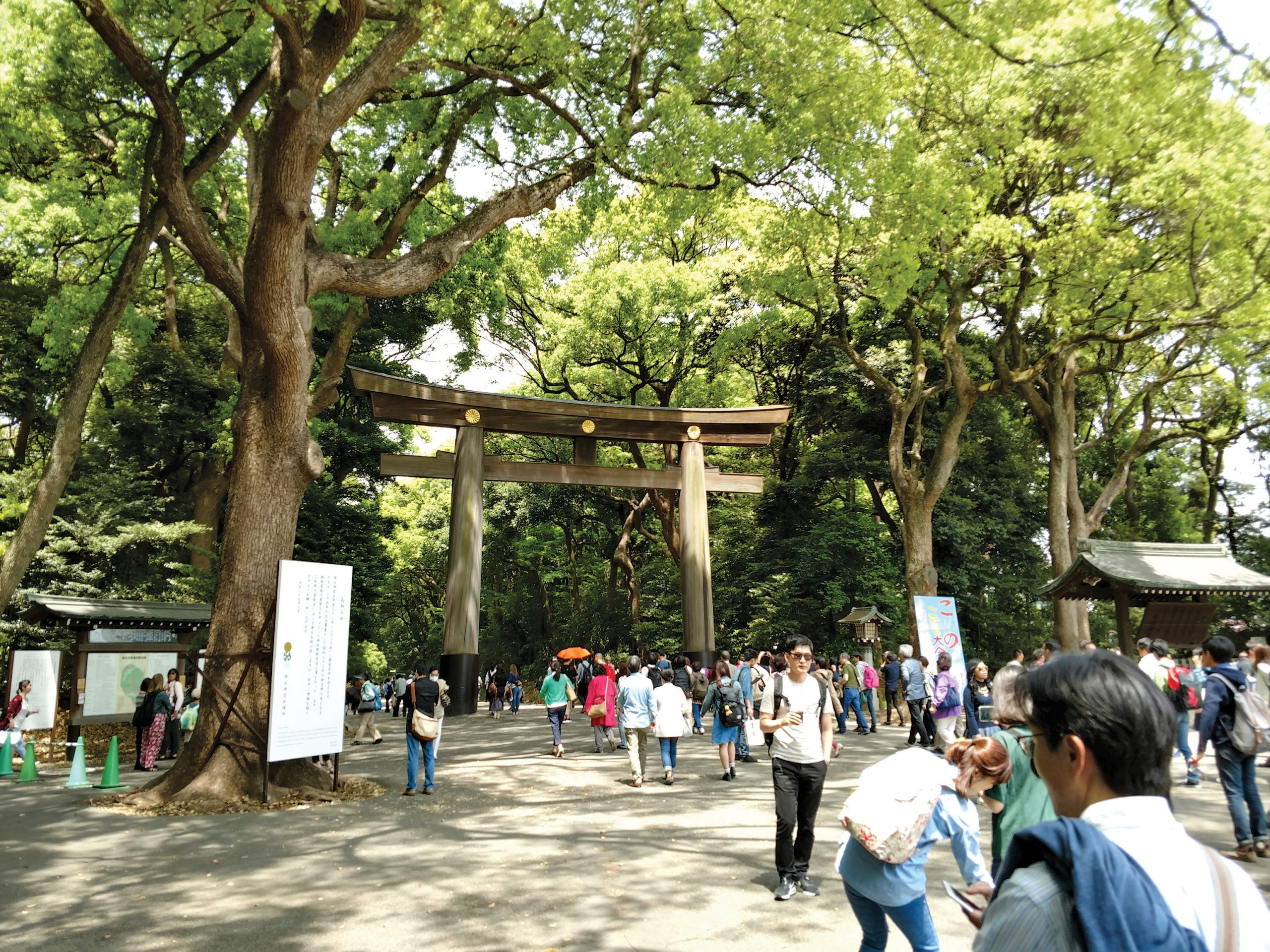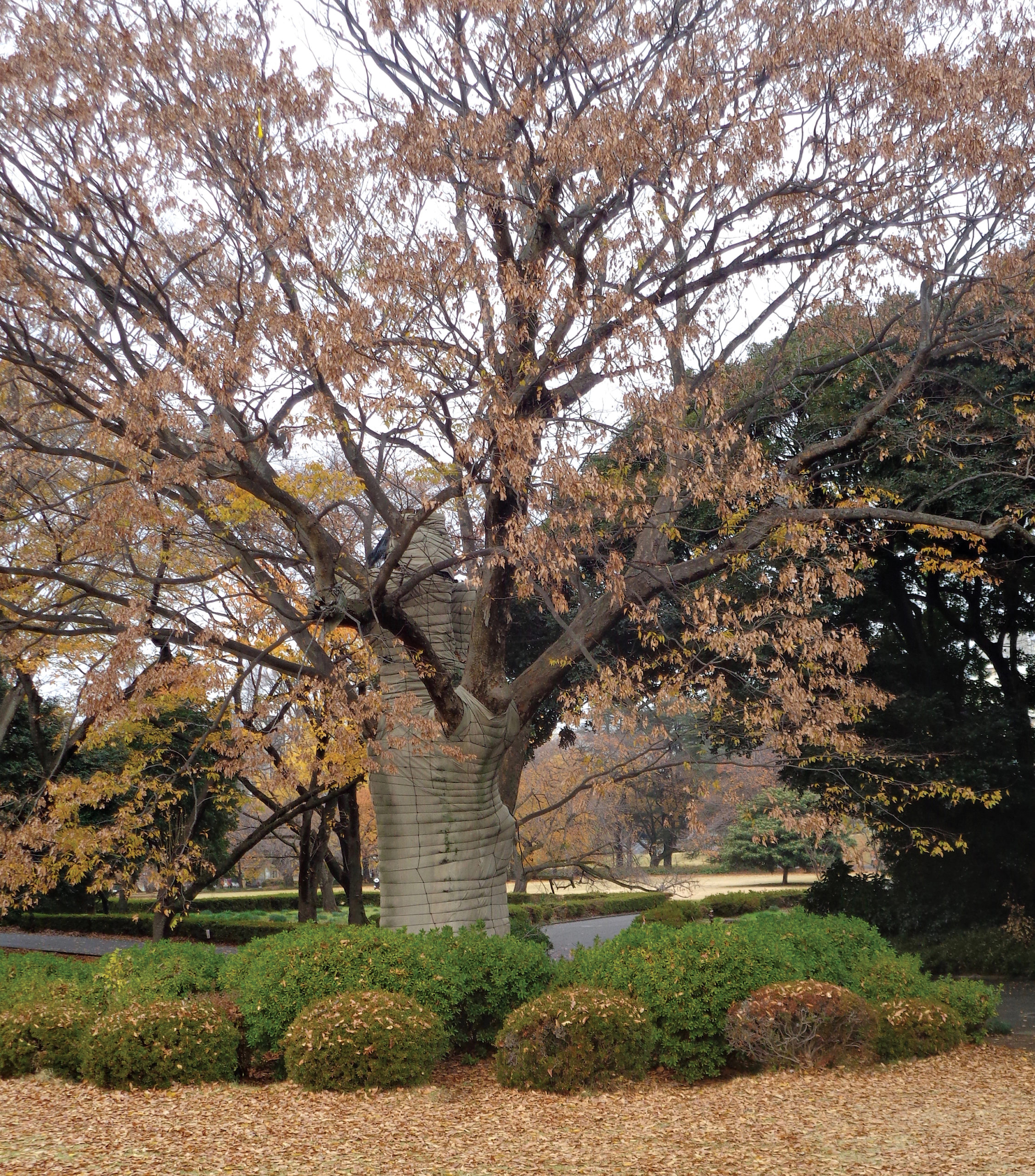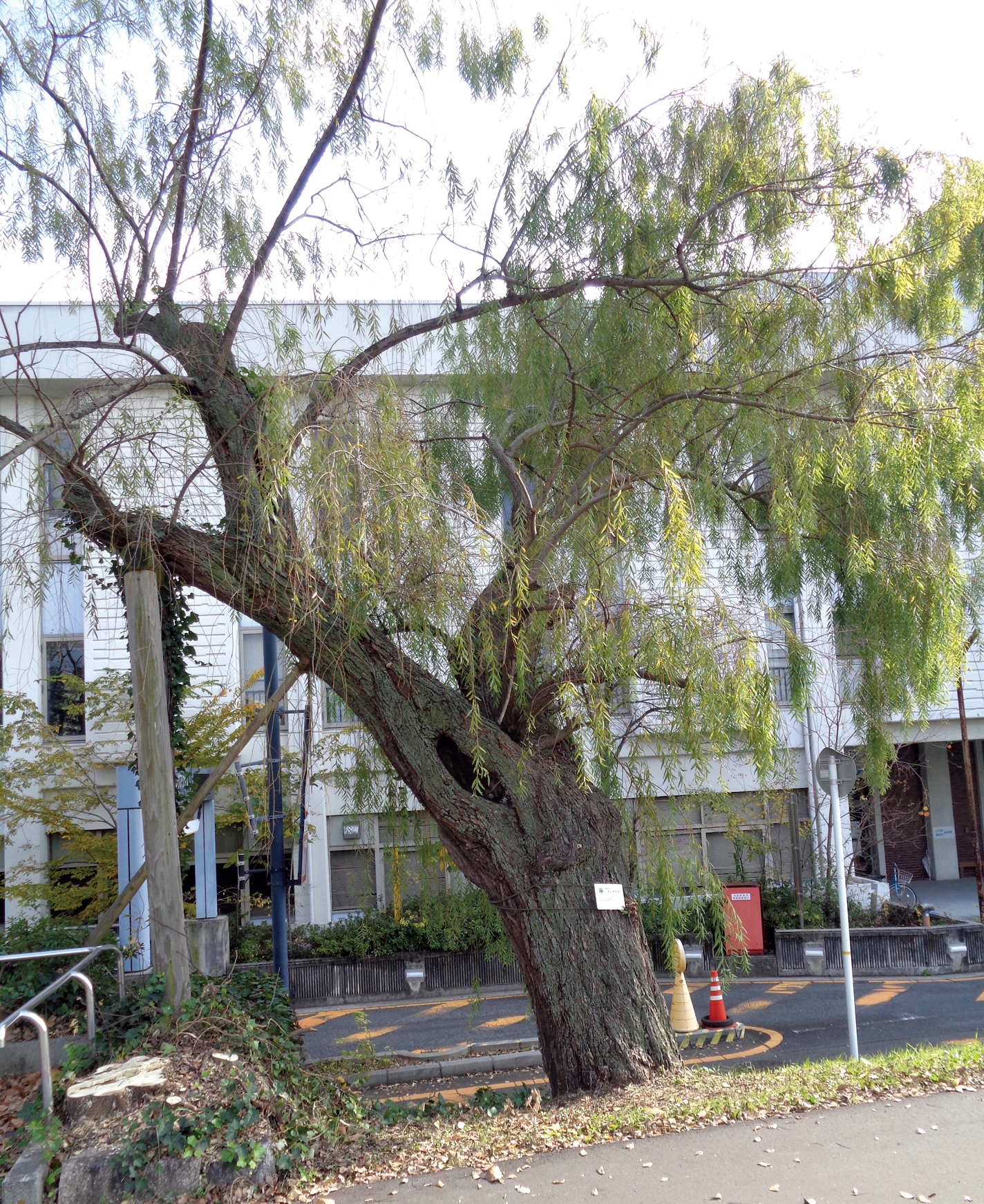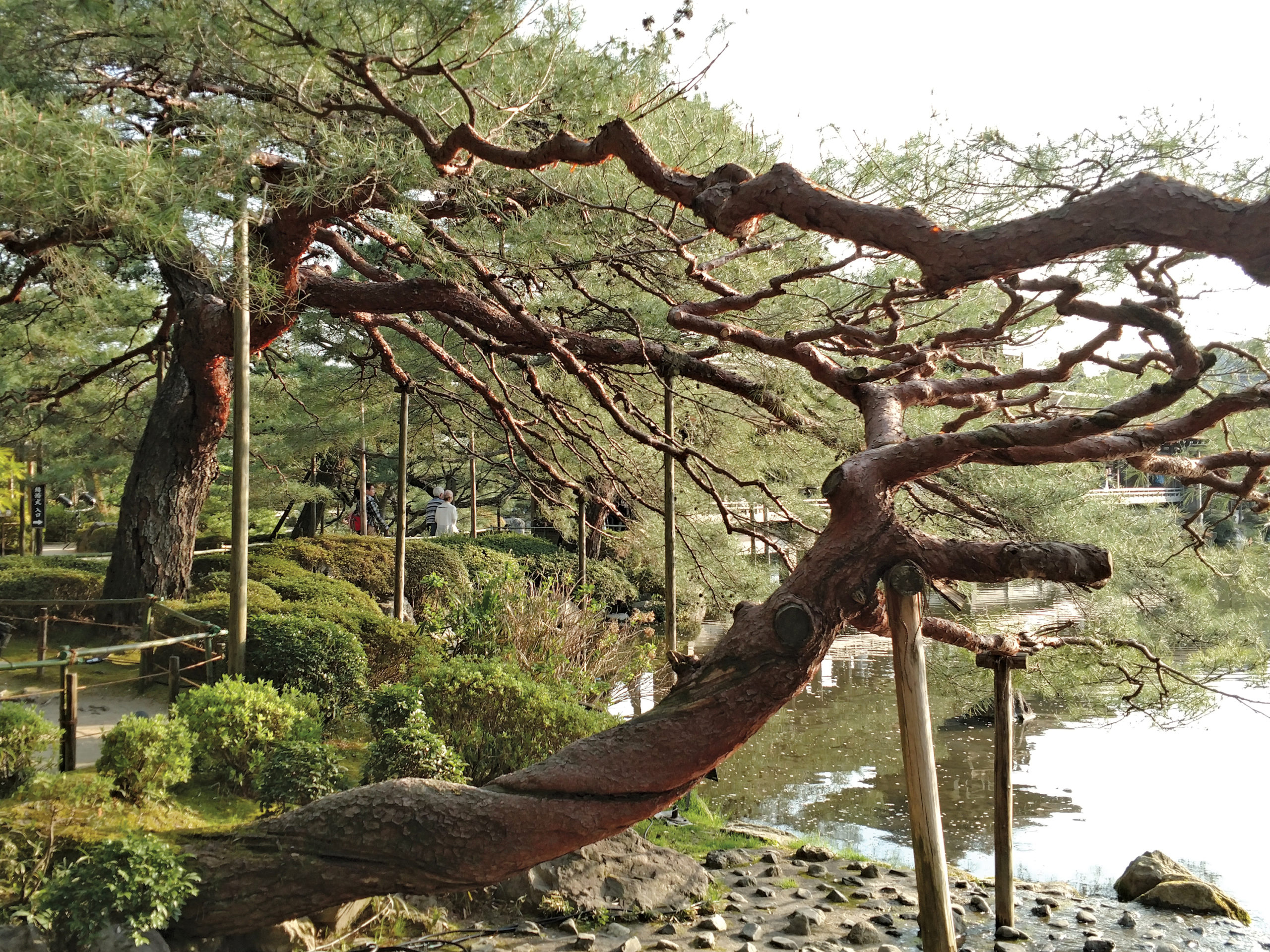The accounts of foreign visitors who began arriving in Japan after the Meiji Revolution, in 1868, show that the newcomers were intrigued by the Japanese relationship with trees. Sacred trees were noted as important features around shrines. Old trees were marveled over, especially given the affectionate care the trees received, as were the miniature bonsai that could be hundreds of years old and require daily tending. But the visitors focused especially on the cherry trees (Prunus serrulata) and their brief but spectacular show of blossoms. Writer Lafcadio Hearn was no exception, and he recorded fables like “The Cherry Tree of the Sixteenth Day” in his classic book Kwaidan, published in 1904.1 Tourists today have the same focus, resulting in the peak season for tourism to Japan happening in early April, when the cherry trees are in bloom. Massed blossoms are the perfect photo opportunity—they accounted for a massive twenty-nine million Instagram posts in 2018—and the cherry-blossom-viewing ritual, known as hanami, is an attraction in itself. The ritual involves siting on blue tarpaulins beneath the trees and drinking sake while the fragile blossoms fall. This is promoted to tourists as indicative of a society whose people accept “the fleeting nature of life.”2
Although the symbolism of the cherry blossom certainly seems to fit with a nation that has endured earthquakes, tsunamis, and typhoons, hanami is just a small part of how trees fit into traditional Japanese culture. This relationship is rooted in Japanese history, folklore, and religion. Trees and nature are central to Shinto, a religion that originated in Japan, which holds that spirits inhabit trees that reach one hundred years of age. These tree spirits are known as kodama, and according to Japanese folklore, the kodama give the tree a personality.3 Accordingly, in premodern Japan, old trees were regarded with awe and a degree of caution. In fact, they were marked with a sacred rope called a shimenawa, warning that if anyone chopped down the tree, they would have to deal with an angry spirit.
Although it seems unlikely that these folkloric beliefs could survive in modern, urbanized Japan, they proved surprisingly adaptable. The idea of tree spirits was kept alive in storybooks and anime (most notably the Hayao Miyazaki film Princess Mononoke), and belief in the presence of kodama in old trees continues. So, while it might be more accurate to say that many of today’s Tokyoites are likely to think in terms of old trees having admirable qualities rather than personalities, they nevertheless respect the trees for their age and resilience, and can be seen paying homage to them at shrines and in parks, or simply spending time in their presence as an antidote to the stress of modern life.
Eternal Forest in Tokyo
Tokyo is a modern city, and to a visitor, its residents seem totally immersed in their busy, modern lives. Salarymen dressed in suits and ties rush from train stations to their offices; young people sit in coffee shops engrossed in their phones; and people shop in gleaming department stores. It is easy to lose sight of the fact that Japanese traditions and myths persist behind what writer and cultural historian Boyé De Mente refers to as a “Western façade.”4 While not everyone today believes in the ancient myths in a literal sense, Shinto master Motohisa Yamakage has described how myths and related Shinto beliefs are still woven into the fabric of everyday Japanese life.5 For example, construction crews typically wait for a Shinto priest to purify a new worksite; major league baseball teams like the Hiroshima Carp receive a Shinto blessing before spring training; and almost everyone visits one of Japan’s eighty thousand Shinto shrines on ceremonial occasions. It is during these shrine visits that the role played by trees in connecting people with the nation’s mythic past becomes apparent.
Meiji Jingū, a shrine in Tokyo, is not old by Japanese standards. It was completed in 1920 to honor Emperor Meiji and Empress Shōken. All Shinto shrines are surrounded by trees, which are thought to provide a conduit to the gods. While these shrine forests, or chinju no mori, are ideally “old primeval forests,” providing a living link to “the ancient age of myths,”6 everything at Meiji Jingū had to be planted from scratch, which required a staggering one hundred thousand trees. The long-term goal was to create an “eternal forest” dominated by long-lived trees like zelkova (Zelkova serrata) and ginkgo (Ginkgo biloba), but because of the more immediate need to have a forest with an atmosphere appropriate for a shrine, a 150-year program was devised, whereby fast-growing trees—most notably Hinoki cypress (Chamaecyparis obtusa), Japanese cryptomeria (Cryptomeria japonica), and two species of pine (Pinus densiflora and P. thunbergii)—provided at least the appearance of a chinju no mori before the slower-growing, broadleaf species gradually took over.7

Even with fifty of the 150-year program remaining, the Meiji Jingū forest has begun to feel old. It attracts ten million visitors every year, with three million coming in the three days after the New Year to pray. Wishes for the coming year are written on wooden tablets called ema, and these are left at the foot of a camphor tree (Cinnamomum camphora), which is believed to transmit the wishes to the deified emperor and empress. Visitors repay the trees with affection and respect, and the shrine’s tree-viewing etiquette is rigidly adhered to. As soon as visitors pass through the ceremonial wooden torii (gate) they are in sacred space, and a quiet, respectful demeanor is assumed. No one leaves the paths to walk on the forest floor; no one picks leaves or seeds from a tree; and no one removes anything from the forest—even fallen leaves are left on the ground.
Fabled Trees of Tokyo
The desire to connect with Japan’s spiritual and mythic past is accompanied by a strong feeling of connectedness with the nation’s history. As a result, a number of Tokyo parks and gardens with old trees that have witnessed the city’s history unfold have been given status as national monuments and historical landmarks. One of the most popular of Tokyo’s historic landmark parks is the Institute for Nature Study, a 49-acre (20-hectare) forest that doubles as a research facility and a green oasis for the people of Tokyo. The Institute for Nature Study was once the feudal estate of the Matsudaira, a samurai clan related to the shogun (the military ruler of Japan). The star attraction is the Fabled Pine, an enormous Japanese black pine (Pinus thunbergii) that was part of the Matsudaira garden in the early 1600s. People typically bow before the old tree, which provides a living link to this emblematic era of Japanese culture—a symbol of cultural continuity.
The Fabled Pine also offers a reassuring example of resilience. The old tree’s never-say-die spirit was underscored when the second-oldest tree in the Institute for Nature Study forest, a Japanese black pine known as the Ancient Pine, was toppled by a typhoon in October 2019. The fact that the Fabled Pine survived when even its venerable neighbor succumbed has only added to its mystique. Indeed, many of the visitors who stream up to the tree every day would be aware that the tree had survived a long list of disasters that began with the Great Fire of Meireki, in 1657. That fire burned 70 percent of the city and took over one hundred thousand lives—far more destructive and deadly than the Great Fire of London, nine years later. Earthquakes were also a constant threat. Major quakes hit the city in 1703, 1855, and 1894; then in 1923, the biggest of them all, the Great Kantō Earthquake, flattened most of the city. During World War II, Tokyo was spared the horror of the atomic bomb, but the city’s trees were decimated by the relentless American firebombing.8

The chances of any tree surviving this litany of disasters is illustrated by the fact that of the twenty thousand trees in Shinjuku Gyoen, one of Tokyo’s largest parks, only two, a 150-year-old magnolia (Magnolia denudata) and a 400-year-old zelkova (Zelkova serrata), are over one hundred years old. The zelkova—the star attraction—is showing signs of age. Its trunk was severed about ten feet from the ground, and new branches poke through a protective coat that was wrapped around the trunk to nurse the tree back to health. On face value, a tree that needs to be nursed back to health is an unlikely symbol of resilience, but as J. W. T. Mason has explained, according to Japanese tradition, great age and “special hardihood” are evidence of a tree’s “vital powers.”9 The broken trunk and protective coat emphasize the battles the tree has fought, and give heart to residents of Tokyo that they can cope with the stresses and strains of their daily commute, long working hours, or, if they are young, looming exams.
Survivor Trees of Hiroshima
Never was Japanese resilience tested more than in the aftermath of the atomic bomb dropped on Hiroshima, in 1945. The bomb blast and resulting fires killed 140,000 people and destroyed all but a few buildings within an approximately 1.2-mile (2-kilometer) radius of the hypocenter. Survivors then began experiencing radiation sickness, resulting in death from cancer. At first it seemed as though the city’s trees were following a similar trajectory. Most were instantly torn out of the ground or had their trunks snapped in half. The few trees left standing were seared by a blast of heat so intense that a streetcar over a half mile (900 meters) from the hypocenter was completely oxidized. As one city administrator put it, the bomb had reduced the city to “an ashen coloured wasteland bereft of all green.”10 The fear was that nothing would grow in the radiation-affected soil for seventy-five years.
Not surprisingly, residents were resigned to abandoning the city, when, almost miraculously, green shoots began emerging from some of the blackened, charred branches. A few trees, so burned and broken that they had no viable branches left, somehow managed to sprout new shoots out of their blackened stumps. A weeping willow (Salix babylonica), merely 0.2 miles (370 meters) from the hypocenter, was completely felled by the blast but managed to send up new shoots directly from its roots.


In all, 170 trees regrew after the blast. Hibakusha (people who survived the bomb) have given testimony that the resilience shown by the hibaku jumoku (survivor trees) helped convince them that life could return to the city. Akio Nishikori was a second grader when the bomb fell. “We were told nothing would grow for seventy-five years,” he recalled. “However, trees put out new shoots! Everyone was really moved to see the green leaves. These trees were the first to encourage humans [to rebuild.]”11
In 1946, governor Kusunose Tsunei enlisted six community representatives to help him formulate a plan for restoring the city. As a city administrator explained, the consensus was not to “create everything anew.” Rather, the aim was to restore the “social functions, culture, and traditions that had existed in the Hiroshima communities before the bombing.”12 This meant many things. Hiroshima Castle, flattened by the bomb, was rebuilt. Hondōri, the city’s ornate shopping arcade, was restored to its former glory. But most importantly, Kusunose’s panel was adamant that “many trees should be replanted in the city.”13 It was no small task to grow trees in soil that had been burned by a nuclear blast and that was laced with rubble and debris, but today Hiroshima is a green city. Trees growing in parks and along rivers and roads give Hiroshima the look and feel it had before the war.
The survivor trees provided living links to that prewar period, and the city was effectively rebuilt around them. Commemorative plaques were installed, and the trees have been preserved and tended into old age, even in cases when it might have been more convenient to remove them. A fine example of this respect is an old ginkgo (Ginkgo biloba) that, before the bomb was dropped, stood on the grounds of the Hosenbo Temple. The temple was levelled by the blast, and the head priest and his family were killed. The ginkgo had branches torn off and was badly burned, but it survived. When rebuilding began in 1994, the priests realized that the ginkgo, now a very large tree, would have to be removed to accommodate the architectural plans. Not willing to cut down a tree that had displayed such courage, they asked the architect to alter the plans, so that the temple could be built around it, preserving the tree as a symbol of resilience and continuity.
Walking among Old Trees
In 1982, Tomohide Akiyama, director of the Japanese Ministry of Forestry and Fisheries, coined a new term: shinrin-yoku (forest bathing.)14 In fact, although it was a new word, the idea was connected to the very old Japanese notion that being among trees was good for health. In time the idea would become mainstream, with books written about how to get the most out of forest bathing and with one thousand government-accredited Official Recreation Forests now including shinrin-yoku trails. But when Akiyama coined the term, in 1982, he was also responding to a growing unease about the shift from agrarian to urban lifestyles, and the stress of modern life. By the 1980s, 80 percent of the Japanese population was concentrated in cities, seemingly far removed from nature. Long commutes, even longer workdays, and the constant pressure of not making a mistake would lead to Japan becoming recognized as the most sleep-deprived country on earth. There is even a Japanese word—karoshi—for the concept of death by overwork.15
Initially, there was no scientific basis for Akiyama’s assertion that “being in the forest makes our bodies healthy,” but there was a sense that the idea was at least plausible.16 Chiba University horticulture professor Yoshifumi Miyazaki, who would later conduct studies on the value of shinrin-yoku, described this prevailing sentiment: “The practice of walking slowly through the woods, in no hurry,” made “intuitive” sense to the Japanese.17 This intuition was partly rooted in knowing how much better it was to smell pine trees instead of car fumes, or to hear birds instead of harsh city noises, but at a spiritual level, it was also connected to the deep traditions associated with trees. As Shinto Studies professor Sadasumi Motegi put it, shrine forests and parks with old trees “are places that remind one of distant, ancient times. This is where the voices of the gods (kamigami) sound in your ears. This is where our ancestors lived, humbly, in harmony with nature.”18

In 1990, in a study funded by the Japanese national broadcaster NHK, Miyazaki set out to test whether the spiritual benefits of reconnecting with nature were matched by medical benefits. To that end, he monitored the effects of walking through a forest on stress hormone levels in the human body. The findings were promising but inconclusive. Subsequently, he received a large government-funded grant allowing him to conduct more detailed studies. These studies have shown that there are not only emotional benefits from spending time in a forest but also measurable physiological benefits. For instance, office workers with stress-related high blood pressure had their levels lowered after spending six hours in an old growth forest. But the truly remarkable thing was that those with low blood pressure had their levels raised.19 In effect, forest bathing, or shinrin-yoku, restores the balance that is so hard to achieve in modern life.
While science has supported the effectiveness of shinrin-yoku, the spiritual element involved has made it harder to explain in scientific terms how it works. As Miyazaki conceded in 2018, “we need to do more research.” What is known, however, is that it works best in an unspoiled forest setting, pristine enough for moss to grow freely, and where old trees live. Moreover, shinrin-yoku requires intentionality to work correctly. As Qing Li, the chairman of the Japanese Society of Forest Medicine, cautioned, “This is not exercise or hiking, or jogging. It is simply being in nature, connecting with it through our sense of sight, hearing taste, smell and touch.”20 In other words, forest bathers should proceed at the same sedate pace and with the same quiet, respectful attitude as when they visit a shrine forest.
Bridging Past and Present
Japanese city parks all at least aspire to a natural, unspoiled look, and many contain astoundingly old trees. This design intention is evident, even to a traveler, looking for cherry blossoms. Flower beds, a staple of parks in Western cities, are rare, and any lawns come with rules prohibiting ball games, music, or other activities that would shatter the serenity. Jogging is rarely permitted. When the Fabled Pine at the Institute for Nature Study, in Tokyo, was first planted under the auspices of the Matsudaira clan, more than four hundred years ago, the residents of the estate could never have imagined modern cities like Tokyo or Hiroshima. However, one thing they would find comfortingly familiar is the sustained relationship with trees. Shrine trees are still sacred. And old trees are still revered for their resilience, and they still provide a bridge back to the past—indeed, even to the Matsudaira clan itself.
As visitors at the Institute for Nature Study walk along the narrow path that wends through the trees, around ponds and over creeks, the city seems a million miles away. It was as if the park was designed specifically with shinrin-yoku in mind. The older trees are not, as in many parks, “features,” standing unnaturally apart from the rest of the plants. Instead they rise through a bed of saplings and bushes. Moss covers everything, underscoring the sense that the trees are growing in a pure, natural environment. Although Tokyo has changed so much over the last four hundred years, the Matsudaira clan would surely recognize the thinking behind shinrin-yoku, namely that spending time with trees is a life-giving activity.
Endnotes
1 Hearn, L. 1904. Kwaidan: Stories and studies of strange things in Japan. Boston: Houghton Mifflin, 139–141.
2 Ishikura, Y. 2019, April 3. Hanami a reminder of life’s fleeting nature. Japan Times. Retrieved from https://www.japantimes.co.jp/opinion/2019/04/03/commentary/japan-commentary/hanami-reminder-lifes-fleeting-nature
3 Shirane, H. 2013. Japan and the culture of the four seasons: Nature, literature, and the arts. New York: Columbia University Press, 128. Note: According to Shirane, farmers believed that trees had emotions, and a tree would scream or groan when it was cut.
4 De Mente, B. 2018. Japan: A guide to traditions, customs, and etiquette. Tokyo: Tuttle, 10. (Original work published as Kata: The key to understanding & dealing with the Japanese, 2003).
5 Yamakage, M. 2006. The essence of Shinto: Japan’s spiritual heart. Tokyo: Kodansha International, 11. See also: Hardacre, H. 2017. Shinto: A history. New York: Oxford University Press, 16.
6 Rots, A. 2017. Shinto, nature and ideology in contemporary Japan: Making sacred forests. London: Bloomsbury, 85.
7 Matsui, T. 1996. Meiji Shrine: An early old-growth forest creation in Tokyo. Restoration and Management Notes, 14(1): 46–52. See also: Saigusa, N. 2005, November. A 150 year-project: Meiji Shrine forest in central Tokyo. Japan For Sustainability Newsletter, no. 39. Retrieved from https://www.japanfs.org/en/news/archives/news_id027807.html.
8 Cheng, S. and McBride, J. 2014. Restoration of the urban forests of Tokyo and Hiroshima following World War II. In K. Tidball and M. Krasny (Eds.), Greening in the red zone: Disaster, resilience and community greening. New York: Springer Books, 225. Note: Ironically, because records were destroyed in the fire-bombing, the exact number of trees lost from parks and gardens is unavailable. However, it is known that over sixty thousand street trees were destroyed in the war.
9 Mason, J. W. T. 2002. The meaning of Shinto. Victoria, Canada: Trafford, 75. (Original work published 1935.)
10 City of Hiroshima. (n. d.) A history of Hiroshima’s greenery. Retrieved February 6, 2020, from http://www.city.hiroshima.lg.jp/www/contents/1274090206341/index.html
11 Green Legacy Hiroshima. (n. d.) An introductory video [Video file in Japanese, with English subtitles]. Retrieved from http://glh.unitar.org/
12 Hiroshima for Global Peace Plan Joint Project Executive Committee. 2015 Hiroshima’s path to reconstruction. Hiroshima: Rijo Printing, 24.
13 Kosakai, Y. 2009. Hiroshima peace reader. Hiroshima: Hiroshima Peace Culture Foundation, 18–19.
14 Miyazaki, Y. 2018. Shinrin-yoku: The Japanese way of forest bathing for health and relaxation. London: Hachette, 10–24.
15 Hoffman, M. 2018, September 8. Japan loses sleep over a variety of modern-day issues. Japan Times. Retrieved from https://www.japantimes.co.jp/news/2018/09/08/national/media-national/japan-loses-sleep-variety-modern-day-issues. Note: A 2016 survey ranked Japan last out of one hundred nations in terms of hours slept per night. Half of Japanese workers get less than six hours sleep a night.
16 Hendy, A. 2018, June 4. The call of the wild: Forest bathing and urban greening. The Japan Journal Online. Retrieved from https://www.japanjournal.jp/science/environment/pt20180604165729.html
17 Miyazaki, 9.
Citation: Moore, G., and Atherton, C. 2020. Eternal Forests: The Veneration of Old Trees in Japan. Arnoldia, 77(4): 24–31.
18 Rots, 85.
19 Miyazaki, 24. Note: for an example of a recent study on the effect of shinrin-yoku, see: Song, I. and Miyazaki, Y. 2017. Sustained effects of a forest therapy program on the blood pressure of office workers. Urban Forestry and Urban Greening, 27: 246–252.
20 Li, Q. 2018. Into the forest: How trees can help you find health and happiness. London: Penguin Random House, 12.
Acknowledgments
The authors would like to thank the staff at the Management Office of the Shinjuku Gyoen for their help and advice.
Glenn Moore taught for many years at the University of Melbourne. He now works for the Japanese national broadcaster Nippon Hoso Kyokai (NHK). Cassandra Atherton is an associate professor in Writing and Literature at Deakin University.
From “free” to “friend”…
Established in 1911 as the Bulletin of Popular Information, Arnoldia has long been a definitive forum for conversations about temperate woody plants and their landscapes. In 2022, we rolled out a new vision for the magazine as a vigorous forum for tales of plant exploration, behind-the-scenes glimpses of botanical research, and deep dives into the history of gardens, landscapes, and science. The new Arnoldia includes poetry, visual art, and literary essays, following the human imagination wherever it entangles with trees.
It takes resources to gather and nurture these new voices, and we depend on the support of our member-subscribers to make it possible. But membership means more: by becoming a member of the Arnold Arboretum, you help to keep our collection vibrant and our research and educational mission active. Through the pages of Arnoldia, you can take part in the life of this free-to-all landscape whether you live next door or an ocean away.

